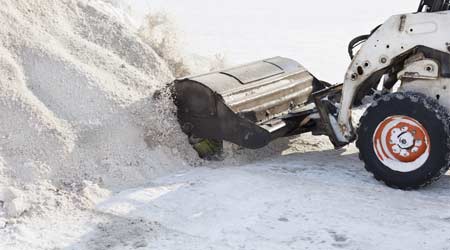Five Minutes With Audio & Video Home
fiveminuteswith
Discussing Snow and Ice Removal Challenges at a National Park Service Site in Washington D.C.

Diana Bramble, a supervisory horticulturist with the National Park Service at Rock Creek Park in Washington D.C., discusses the snow and ice removal process at the 3,000-acre urban park. Diana's team is responsible for 21 miles of roadway and 22 miles of sidewalks. The sidewalks are a special challenge, as they spread throughout the city over a 50-mile radius and 99 separate land units. Rock Creek Park was founded in 1890 and is one of the country's first federal parks.

Diana Bramble
supervisory horticulturist
National Park Service at Rock Creek Park in Washington D.C.
1. At what point during the calendar year do you begin preparations for your park's snow and ice removal plan?
We start planning for snow removal operations in August of each year. At that time we begin purchasing supplies such as ice melt, road salt, snow shovels, and parts for sanders and plows. The preparations continue through the fall to include updating our standard operating procedures and getting all of the equipment ready to hit the ground. Our target date for full readiness is October 15th.
2. Describe the process you go through as a manager when a significant snowstorm is forecast.
The first thing we do when any amount of snow is forecast is to closely watch the models and monitor the predictions in regards to the quantity of precipitation, air temperatures, and length of the storm. We use this information to make decisions regarding staffing needs, materials to be used, and fleet deployment.
3. What are some of the challenges involved with adjusting staffing schedules to accommodate snow removal shifts?
We notify employees as soon as possible when a snow event appears imminent. Snow can be incredibly disruptive to set work schedules. It is important as a manager to meet the needs of the work site while being courteous to the people who are charged with the responsibility of maintaining the roads, buildings, and sidewalks. Work schedules are adjusted to account for multiple shifts to account for snow removal operations throughout the duration of a snow event as well as continued clean up once the event ends. This means that an employee may work multiple shifts until snow removal operations are complete for a single storm. It is important to ensure that work schedules are spaced in a manner that allows enough rest for staff to work in a safe manner until a snow event ends.
4. How do you prioritize duties when snow removal shifts are required?
Snow operations are an all-hands-on-deck situation. That means that everyone in the maintenance division has a role during a storm that may not reflect their primary job description. People are matched to snow removal tasks that reflect their experience and capabilities to ensure that operations run smoothly. Our primary duties have to take a back seat to snow removal operations until the task is complete. Snow removal is paramount to public safety, so that is the number one priority.
5. What lessons have you learned as a manager about the snow and ice removal process after an especially tough winter?
I find that we learn something new as a team after each snow season. I think the feedback received from staff and the public has informed us how we will plan for individual snow events next year as well as the way that we communicate out on the status of our operations. Additionally, tough winters push the limits of equipment, which helps us determine what will best meet our needs in the future.
posted: 4/8/2015









